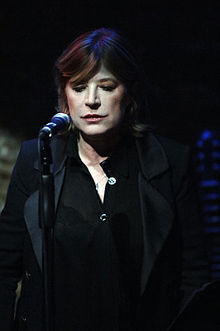
The Beatles, also referred to colloquially as the White Album, is the ninth studio album and only double album by the English rock band the Beatles, released on 22 November 1968. Featuring a plain white sleeve, the cover contains no graphics or text other than the band's name embossed. This was intended as a direct contrast to the vivid cover artwork of the band's previous LP Sgt. Pepper's Lonely Hearts Club Band (1967). The Beatles is recognised for its fragmentary style and diverse range of genres, including folk, country rock, British blues, ska, music hall, proto-metal and the avant-garde. It has since been viewed by some critics as a postmodern work, as well as one of the greatest albums of all time.
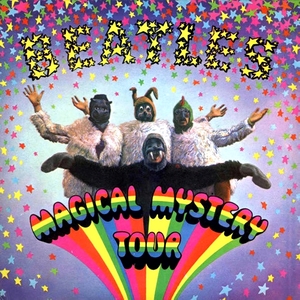
Magical Mystery Tour is a record by the English rock band the Beatles that was released as a double EP in the United Kingdom and an LP in the United States. It includes the soundtrack to the 1967 television film of the same name. The EP was issued in the UK on 8 December 1967 on the Parlophone label, while the Capitol Records LP release in the US and Canada occurred on 27 November and features an additional five songs that were originally released as singles that year. In 1976, Parlophone released the eleven-track LP in the UK.

"I Am the Walrus" is a song by the English rock band the Beatles from their 1967 television film Magical Mystery Tour. Written by John Lennon and credited to Lennon–McCartney, it was released as the B-side to the single "Hello, Goodbye" and on the Magical Mystery Tour EP and album. In the film, the song underscores a segment in which the band mime to the recording at a deserted airfield.
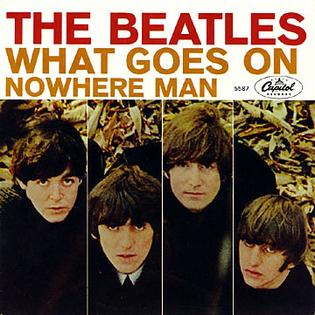
"What Goes On" is a song by the English rock band the Beatles, featured as the eighth track on their 1965 album Rubber Soul. The song was later released as the B-side of the US single "Nowhere Man", and then as the tenth track on the North America-only album Yesterday and Today. It is the only song by the band credited to Lennon–McCartney–Starkey and the only song on Rubber Soul that features Ringo Starr on lead vocals. The song reached number 81 on the US Billboard Hot 100 in 1966.

"You Know My Name (Look Up the Number)" is a song by the English rock band the Beatles released initially as the B-side of the single "Let It Be" on 6 March 1970. Although first issued with their final single (and the penultimate single in the United States), the Beatles recorded the song in four separate sessions, beginning with three in May and June 1967, shortly after completing their album Sgt. Pepper's Lonely Hearts Club Band, with one final recording session conducted in April 1969. The song features a saxophone part played by Brian Jones of the Rolling Stones.
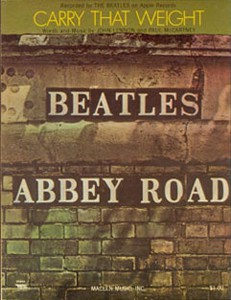
"Carry That Weight" is a song by the English rock band the Beatles from their 1969 album Abbey Road. Written by Paul McCartney and credited to Lennon–McCartney, it is the seventh and penultimate song in the album's climactic side-two medley. It features unison vocals in the chorus from all four Beatles, a rarity in their songs. It is preceded by "Golden Slumbers" and segues into "The End".

"Martha My Dear" is a song by the English rock band the Beatles from their 1968 double album The Beatles. Credited to Lennon–McCartney, the song was written solely by Paul McCartney inspired in title only by his Old English Sheepdog, Martha. The song has been interpreted as a veiled reference to his break up with Jane Asher, particularly in the line "don't forget me". "Help yourself to a bit of what is all around you" refers to her alleged affair while away from McCartney with The Old Vic Theatre. It has been covered by several artists, including Slade, Herb Alpert & The Tijuana Brass, Phish, World Party, and Les Boréades de Montréal.

"Don't Pass Me By" is a song by the English rock band the Beatles from their 1968 double album The Beatles. A country rock song, it was the first solo composition written by drummer Ringo Starr.

"She's Leaving Home" is a song by the English rock band the Beatles, written by Paul McCartney and John Lennon, and released on their 1967 album Sgt. Pepper's Lonely Hearts Club Band. Paul McCartney wrote and sang the verse and John Lennon wrote the chorus, which they sang together. Neither George Harrison nor Ringo Starr were involved in the recording. The song's instrumental background was performed entirely by a small string orchestra arranged by Mike Leander, and is one of only a handful of Beatles recordings in which none of the members played a musical instrument.

"All I've Got to Do" is a song written by John Lennon and performed by the English rock band the Beatles on their second British album, With the Beatles (1963). In the United States, "All I've Got to Do" originally appeared on Meet the Beatles! (1964). According to Dennis Alstrand, the song is the first time in rock and roll or rock music in which the bass player plays chords as a vital part of the song.

"Good Night" is a song by the English rock band the Beatles from their 1968 double album The Beatles. It was written by John Lennon and credited to Lennon–McCartney. The lead vocalist on the recording is Ringo Starr, who was the only Beatle to appear on the track. The music was provided by an orchestra arranged and conducted by George Martin. Written for Lennon's five-year-old son Julian, "Good Night" is the final song on the White Album.
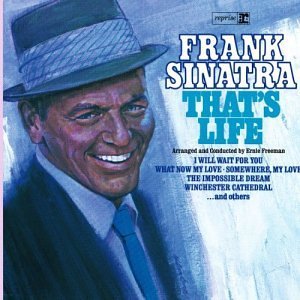
That's Life is a 1966 album by Frank Sinatra, supported by a studio orchestra arranged and conducted by Ernie Freeman. The album is notable for its title song, "That's Life", which proved to be a top five hit for Sinatra at a time when rock music dominated the music charts. That's Life was released on CD in October 1986.

"In Spite of All the Danger" is the first song recorded by the Quarrymen, then consisting of John Lennon, Paul McCartney, George Harrison, pianist John Lowe, and drummer Colin Hanton.
Michael William Sammes was an English musician and vocal session arranger, performing backing vocals on pop music recorded in the UK from 1955 to the 1970s.

"Christmas Time (Is Here Again)" is a Christmas song by the English rock band the Beatles, originally recorded for their fifth fan club Christmas record, Christmas Time Is Here Again! (1967). One of the few Beatles songs credited to all four members of the band, it consists of a blues based backing track as well as double-tracked vocals sung by them, George Martin and Victor Spinetti. The lyrics are mostly made up of the song's title refrain, repeated across nine verses.

"Ain't She Sweet" is a song composed by Milton Ager, with lyrics by Jack Yellen. It was published in 1927 by Ager, Yellen & Bornstein, Inc. It became popular in the first half of the 20th century and typified the Roaring Twenties. Like "Happy Days Are Here Again" (1929), it became a Tin Pan Alley standard. Both Ager and Yellen were elected to the Songwriters Hall of Fame.

"Golden Slumbers" is a song by the English rock band the Beatles from their 1969 album Abbey Road. Written by Paul McCartney and credited to Lennon–McCartney, it is the sixth song of the album's climactic B-side medley. The song is followed by "Carry That Weight" and begins the progression that leads to the end of the album. The two songs were recorded together as a single piece, and both contain strings and brass arranged and scored by producer George Martin.
John O'Neill (1926–1999) was a British musician, known as a singer, whistler, and trumpeter.

"Got to Get You into My Life" is a song by the English rock band the Beatles, first released in 1966 on their album Revolver. It was written by Paul McCartney and credited to Lennon–McCartney. The song is a homage to the Motown Sound, with colourful brass instrumentation and lyrics that suggest a psychedelic experience. "It's actually an ode to pot," McCartney explained. A cover version by Cliff Bennett and the Rebel Rousers, produced by McCartney, peaked at number six in 1966 in the UK. The song was issued in the United States as a single from the Rock 'n' Roll Music compilation album in 1976, six years after the Beatles disbanded. Another cover version by Earth, Wind & Fire from the Sgt. Pepper's Lonely Hearts Club Band film soundtrack peaked at number nine in the US in 1978.
Alexander "Bobby" Kok was a South African-born British professional cellist.


